 credit – MIT Sustainable Concrete Lab
credit – MIT Sustainable Concrete LabCement Supercapacitors Could Turn the Concrete Around Us into Massive Energy Storage Systems
 credit – MIT Sustainable Concrete Lab
credit – MIT Sustainable Concrete LabIndian researchers develop smart portable device to detect toxic pesticides in water, food

New Airship-style Wind Turbine Can Find Gusts at Higher Altitudes for Constant, Cheaper Power

 Altaeros’ BAT – credit, Altaeros, via MIT
Altaeros’ BAT – credit, Altaeros, via MITBiodegradable Plastic Made from Bamboo Is Stronger and Easy to Recycle
 Bamboo forest – credit Bady Abbas, via Unsplash
Bamboo forest – credit Bady Abbas, via UnsplashThe Subtle Power of Unhearable Sound: Mood and Cognition-Altering Agents

Blue, green, brown, or something in between – the science of eye colour explained
You’re introduced to someone and your attention catches on their eyes. They might be a rich, earthy brown, a pale blue, or the rare green that shifts with every flicker of light. Eyes have a way of holding us, of sparking recognition or curiosity before a single word is spoken. They are often the first thing we notice about someone, and sometimes the feature we remember most.
Across the world, human eyes span a wide palette. Brown is by far the most common shade, especially in Africa and Asia, while blue is most often seen in northern and eastern Europe. Green is the rarest of all, found in only about 2% of the global population. Hazel eyes add even more diversity, often appearing to shift between green and brown depending on the light.
So, what lies behind these differences?
It’s all in the melanin
The answer rests in the iris, the coloured ring of tissue that surrounds the pupil. Here, a pigment called melanin does most of the work.
Brown eyes contain a high concentration of melanin, which absorbs light and creates their darker appearance. Blue eyes contain very little melanin. Their colour doesn’t come from pigment at all but from the scattering of light within the iris, a physical effect known as the Tyndall effect, a bit like the effect that makes the sky look blue.
In blue eyes, the shorter wavelengths of light (such as blue) are scattered more effectively than longer wavelengths like red or yellow. Due to the low concentration of melanin, less light is absorbed, allowing the scattered blue light to dominate what we perceive. This blue hue results not from pigment but from the way light interacts with the eye’s structure.
Green eyes result from a balance, a moderate amount of melanin layered with light scattering. Hazel eyes are more complex still. Uneven melanin distribution in the iris creates a mosaic of colour that can shift depending on the surrounding ambient light.
What have genes got to do with it?
The genetics of eye colour is just as fascinating.
For a long time, scientists believed a simple “brown beats blue” model, controlled by a single gene. Research now shows the reality is much more complex. Many genes contribute to determining eye colour. This explains why children in the same family can have dramatically different eye colours, and why two blue-eyed parents can sometimes have a child with green or even light brown eyes.
Eye colour also changes over time. Many babies of European ancestry are born with blue or grey eyes because their melanin levels are still low. As pigment gradually builds up over the first few years of life, those blue eyes may shift to green or brown.
In adulthood, eye colour tends to be more stable, though small changes in appearance are common depending on lighting, clothing, or pupil size. For example, blue-grey eyes can appear very blue, very grey or even a little green depending on ambient light. More permanent shifts are rarer but can occur as people age, or in response to certain medical conditions that affect melanin in the iris.
The real curiosities
Then there are the real curiosities.
Heterochromia, where one eye is a different colour from the other, or one iris contains two distinct colours, is rare but striking. It can be genetic, the result of injury, or linked to specific health conditions. Celebrities such as Kate Bosworth and Mila Kunis are well-known examples. Musician David Bowie’s eyes appeared as different colours because of a permanently dilated pupil after an accident, giving the illusion of heterochromia.
In the end, eye colour is more than just a quirk of genetics and physics. It’s a reminder of how biology and beauty intertwine. Each iris is like a tiny universe, rings of pigment, flecks of gold, or pools of deep brown that catch the light differently every time you look.
Eyes don’t just let us see the world, they also connect us to one another. Whether blue, green, brown, or something in-between, every pair tells a story that’s utterly unique, one of heritage, individuality, and the quiet wonder of being human.![]()
Davinia Beaver, Postdoctoral research fellow, Clem Jones Centre for Regenerative Medicine, Bond University
This article is republished from The Conversation under a Creative Commons license. Read the original article.
The science behind a freediver’s 29-minute breath hold world record

Most of us can hold our breath for between 30 and 90 seconds.
A few minutes without oxygen can be fatal, so we have an involuntary reflex to breathe.
But freediver Vitomir Maričić recently held his breath for a new world record of 29 minutes and three seconds, lying on the bottom of a 3-metre-deep pool in Croatia.
This is about five minutes longer than the previous world record set in 2021 by another Croatian freediver, Budimir Šobat.
Interestingly, all world records for breath holds are by freedivers, who are essentially professional breath-holders.
They do extensive physical and mental training to hold their breath under water for long periods of time.
So how do freedivers delay a basic human survival response and how was Maričić able to hold his breath about 60 times longer than most people?
Increased lung volumes and oxygen storage
Freedivers do cardiovascular training – physical activity that increases your heart rate, breathing and overall blood flow for a sustained period – and breathwork to increase how much air (and therefore oxygen) they can store in their lungs.
This includes exercise such as swimming, jogging or cycling, and training their diaphragm, the main muscle of breathing.
Diaphragmatic breathing and cardiovascular exercise train the lungs to expand to a larger volume and hold more air.
This means the lungs can store more oxygen and sustain a longer breath hold.
Freedivers can also control their diaphragm and throat muscles to move the stored oxygen from their lungs to their airways. This maximises oxygen uptake into the blood to travel to other parts of the body.
To increase the oxygen in his lungs even more before his world record breath-hold, Maričić inhaled pure (100%) oxygen for ten minutes.
This gave Maričić a larger store of oxygen than if he breathed normal air, which is only about 21% oxygen.
This is classified as an oxygen-assisted breath-hold in the Guiness Book of World Records.
Even without extra pure oxygen, Maričić can hold his breath for 10 minutes and 8 seconds.
Resisting the reflex to take another breath
Oxygen is essential for all our cells to function and survive. But it is high carbon dioxide, not low oxygen that causes the involuntary reflex to breathe.
When cells use oxygen, they produce carbon dioxide, a damaging waste product.
Carbon dioxide can only be removed from our body by breathing it out.
When we hold our breath, the brain senses the build-up in carbon dioxide and triggers us to breathe again.
Freedivers practice holding their breath to desensitise their brains to high carbon dioxide and eventually low oxygen. This delays the involuntary reflex to breathe again.
When someone holds their breath beyond this, they reach a “physiological break-point”. This is when their diaphragm involuntarily contracts to force a breath.
This is physically challenging and only elite freedivers who have learnt to control their diaphragm can continue to hold their breath past this point.
Indeed, Maričić said that holding his breath longer:
got worse and worse physically, especially for my diaphragm, because of the contractions. But mentally I knew I wasn’t going to give up.
Mental focus and control is essential
Those who freedive believe it is not only physical but also a mental discipline.
Freedivers train to manage fear and anxiety and maintain a calm mental state. They practice relaxation techniques such as meditation, breath awareness and mindfulness.
Interestingly, Maričić said:
after the 20-minute mark, everything became easier, at least mentally.
Reduced mental and physical activity, reflected in a very low heart rate, reduces how much oxygen is needed. This makes the stored oxygen last longer.
That is why Maričić achieved this record lying still on the bottom of a pool.
Don’t try this at home
Beyond competitive breath-hold sports, many other people train to hold their breath for recreational hunting and gathering.
For example, ama divers who collect pearls in Japan, and Haenyeo divers from South Korea who harvest seafood.
But there are risks of breath holding.
Maričić described his world record as:
a very advanced stunt done after years of professional training and should not be attempted without proper guidance and safety.
Indeed, both high carbon dioxide and a lack of oxygen can quickly lead to loss of consciousness.
Breathing in pure oxygen can cause acute oxygen toxicity due to free radicals, which are highly reactive chemicals that can damage cells.
Unless you’re trained in breath holding, it’s best to leave this to the professionals.![]()
Theresa Larkin, Associate Professor of Medical Sciences, University of Wollongong and Gregory Peoples, Senior Lecturer - Physiology, University of Wollongong
This article is republished from The Conversation under a Creative Commons license. Read the original article.
Retooled Cancer Drugs Eliminated Aggressive Tumors in ‘Remarkable’ New Trial

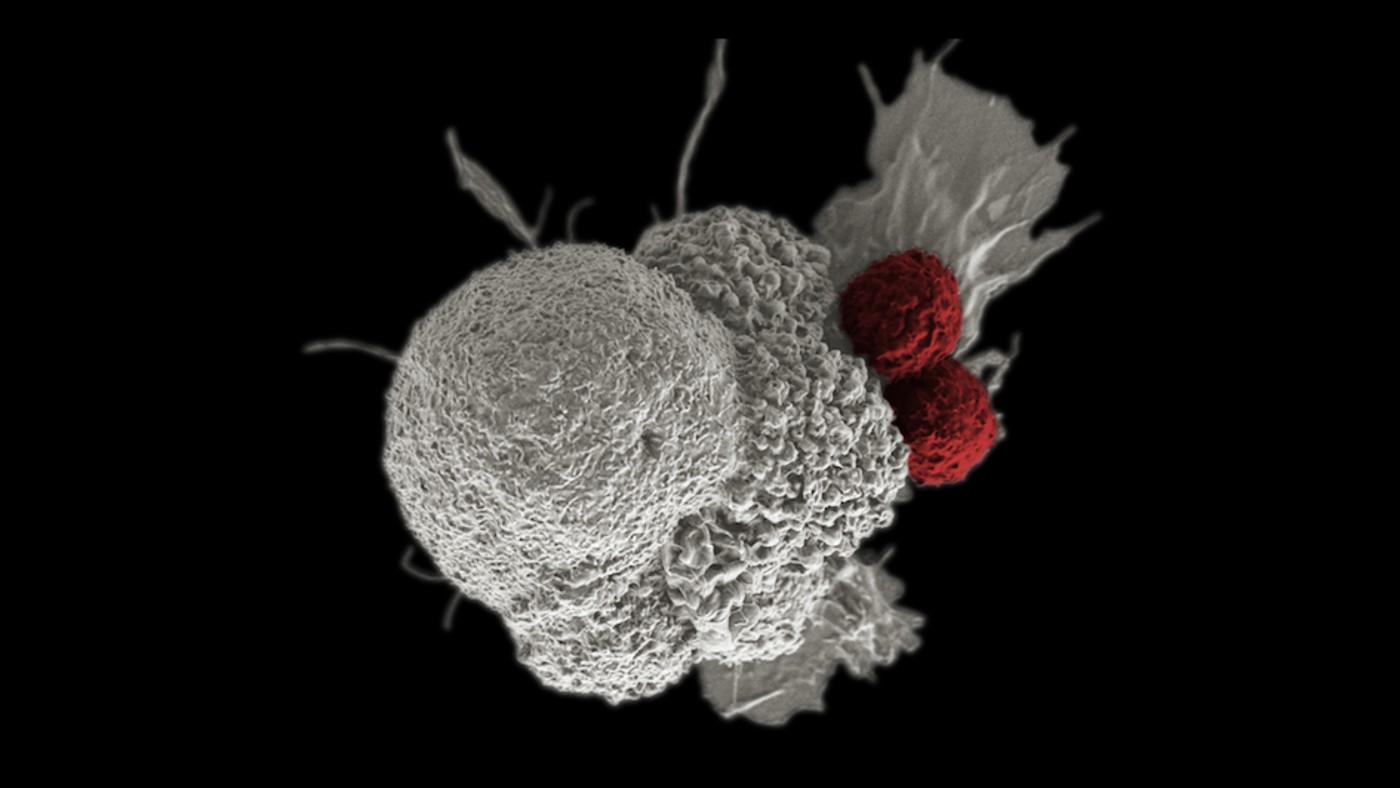 Oral squamous cancer cell (white) being attacked by two cytotoxic T cells (red) – Credit: NIH
Oral squamous cancer cell (white) being attacked by two cytotoxic T cells (red) – Credit: NIHWhat’s a ‘Strombolian eruption’? A volcanologist explains what happened at Mount Etna
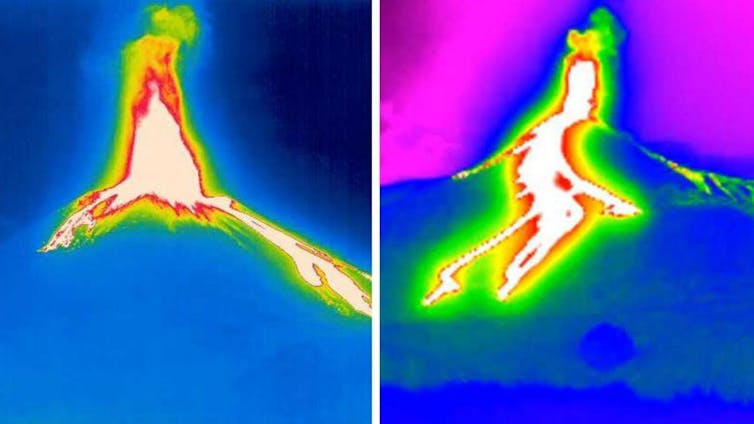 Thermal camera images show the eruption and flows of lava down the side of Mount Etna. National Institute of Geophysics and Volcanology, CC BY
Thermal camera images show the eruption and flows of lava down the side of Mount Etna. National Institute of Geophysics and Volcanology, CC BYTeresa Ubide, The University of Queensland
On Monday morning local time, a huge cloud of ash, hot gas and rock fragments began spewing from Italy’s Mount Etna.
An enormous plume was seen stretching several kilometres into the sky from the mountain on the island of Sicily, which is the largest active volcano in Europe.
While the blast created an impressive sight, the eruption resulted in no reported injuries or damage and barely even disrupted flights on or off the island. Mount Etna eruptions are commonly described as “Strombolian eruptions” – though as we will see, that may not apply to this event.
What happened at Etna?
The eruption began with an increase of pressure in the hot gases inside the volcano. This led to the partial collapse of part of one of the craters atop Etna.
The collapse allowed what is called a pyroclastic flow: a fast-moving cloud of ash, hot gas and fragments of rock bursting out from inside the volcano.
 Thermal camera images show the eruption and flows of lava down the side of Mount Etna. National Institute of Geophysics and Volcanology, CC BY
Thermal camera images show the eruption and flows of lava down the side of Mount Etna. National Institute of Geophysics and Volcanology, CC BYNext, lava began to flow in three different directions down the mountainside. These flows are now cooling down. On Monday evening, Italy’s National Institute of Geophysics and Volcanology announced the volcanic activity had ended.
Etna is one of the most active volcanoes in the world, so this eruption is reasonably normal.
What is a Strombolian eruption?
Volcanologists classify eruptions by how explosive they are. More explosive eruptions tend to be more dangerous, because they move faster and cover a larger area.
At the mildest end are Hawaiian eruptions. You have probably seen pictures of these: lava flowing sedately down the slope of the volcano. The lava damages whatever it runs into, but it’s a relatively local effect.
As eruptions grow more explosive, they send ash and rock fragments flying further afield.
At the more explosive end of the scale are Plinian eruptions. These include the famous eruption of Mount Vesuvius in 79AD, described by the Roman writer Pliny the Younger, which buried the Roman towns of Pompeii and Herculaneum under metres of ash.
In a Plinian eruption, hot gas, ash, and rock can explode high enough to reach the stratosphere – and when the eruption column collapses, the debris falls to Earth and can wreak terrifying destruction over a huge area.
What about Strombolian eruptions? These relatively mild eruptions are named after Stromboli, another Italian volcano which belches out a minor eruption every 10 to 20 minutes.
In a Strombolian eruption, chunks of rock and cinders may travel tens or hundreds of metres through the air, but rarely further. The pyroclastic flow from yesterday’s eruption at Etna was rather more explosive than this – so it wasn’t strictly Strombolian.
Can we forecast volcano eruptions?
Volcanic eruptions are a bit like weather. They are very hard to predict in detail, but we are a lot better than we used to be at forecasting them.
To understand what a volcano will do in the future, we first need to know what is happening inside it right now. We can’t look inside directly, but we do have indirect measurements.
For example, before an eruption magma travels from deep inside the Earth up to the surface. On the way, it pushes rocks apart and can generate earthquakes. If we record the vibrations of these quakes, we can track the magma’s journey from the depths.
Rising magma can also make the ground near a volcano bulge upwards very slightly, by a few millimetres or centimetres. We can monitor this bulging, for example with satellites, to gather clues about an upcoming eruption.
Some volcanoes release gas even when they are not strictly erupting. We can measure the chemicals in this gas – and if they change, it can tell us that new magma is on its way to the surface.
When we have this information about what’s happening inside the volcano, we also need to understand its “personality” to know what the information means for future eruptions.
Are volcanic eruptions more common than in the past?
As a volcanologist, I often hear from people that it seems there are more volcanic eruptions now than in the past. This is not the case.
What is happening, I tell them, is that we have better monitoring systems now, and a very active global media system. So we know about more eruptions – and even see photos of them.
Monitoring is extremely important. We are fortunate that many volcanoes in places such as Italy, the United States, Indonesia and New Zealand have excellent monitoring in place.
This monitoring allows local authorities to issue warnings when an eruption is imminent. For a visitor or tourist out to see the spectacular natural wonder of a volcano, listening to these warnings is all-important.![]()
Teresa Ubide, ARC Future Fellow and Associate Professor in Igneous Petrology/Volcanology, The University of Queensland
This article is republished from The Conversation under a Creative Commons license. Read the original article.
Scientists Define a Color Never Before Seen by Human Eyes, Called 'Olo'–a Blue-Green of Intense Saturation
 Photo by Hamish on Unsplash
Photo by Hamish on UnsplashDiscovery of Genetically-Varied Worms in Chernobyl Could Help Human Cancer Research
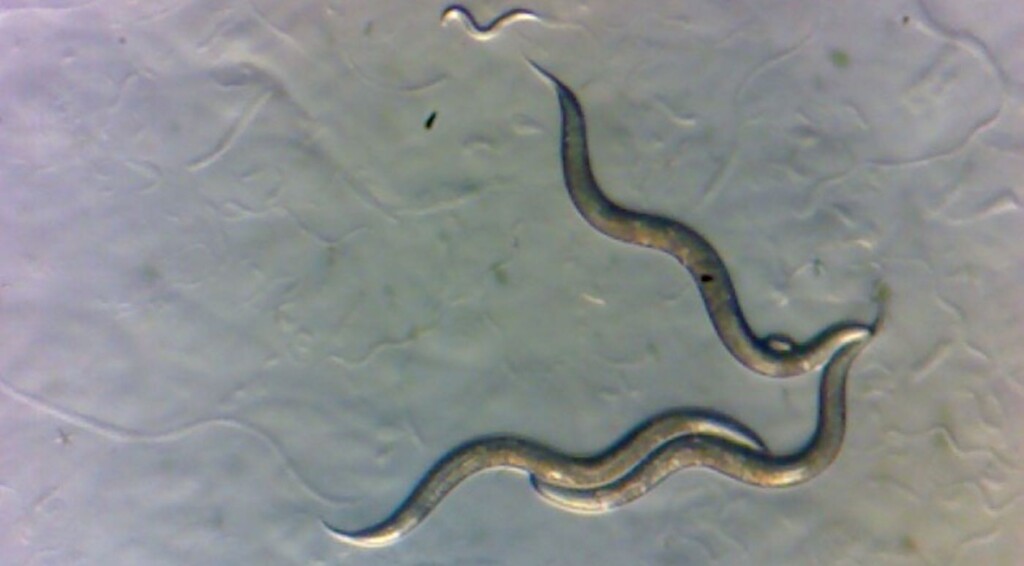 Worms collected in the Chornobyl Exclusion Zone – SWNS / New York University
Worms collected in the Chornobyl Exclusion Zone – SWNS / New York University The ruins of Reactor 4, Chernobyl Exclusion Zone. credit Matt Shalvatis – CC BY-4.0. SA
The ruins of Reactor 4, Chernobyl Exclusion Zone. credit Matt Shalvatis – CC BY-4.0. SAChemical Shield Stops DNA Damage from Triggering Disease–’A Paradigm Shift’
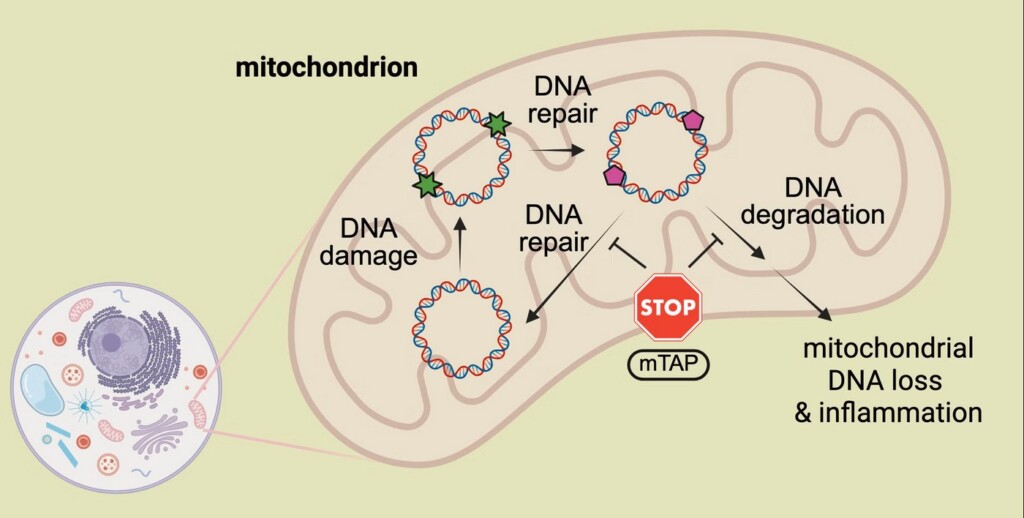 Infographic by Linlin Zhao, University of California Riverside
Infographic by Linlin Zhao, University of California Riverside
Scientists Develop Biodegradable Smart Textile–A Big Leap Forward for Eco-Friendly Wearable Technology
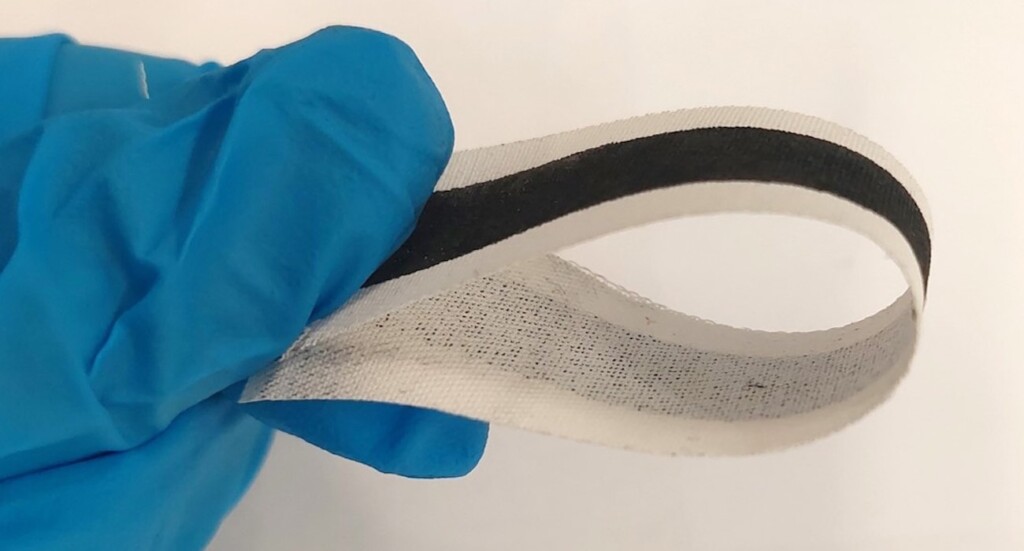 Flexible inkjet printed E-textile – Credit: Marzia Dulal
Flexible inkjet printed E-textile – Credit: Marzia Dulal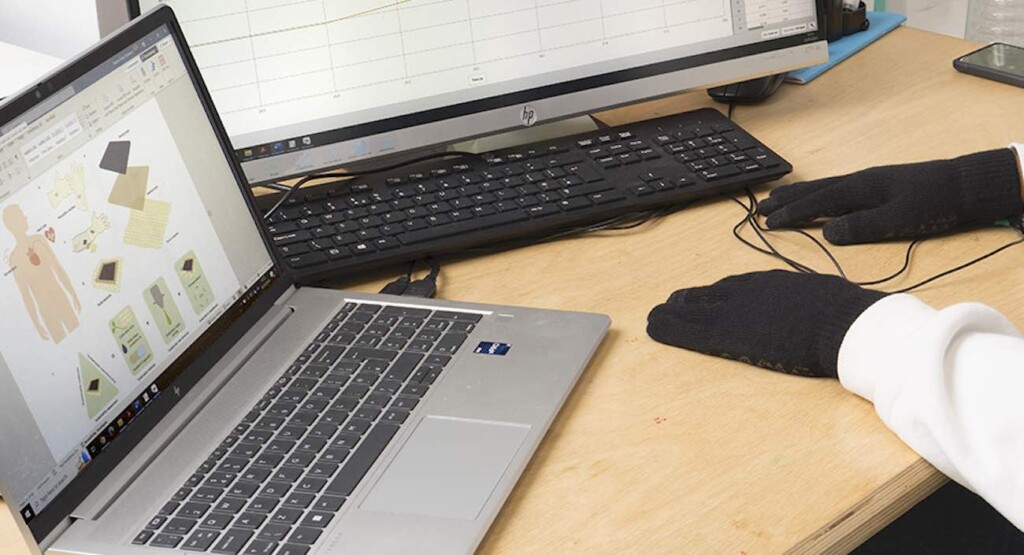 Gloves with e-textile sensors monitoring heart rate – Credit: Marzia Dulal
Gloves with e-textile sensors monitoring heart rate – Credit: Marzia Dulal Four strips in a variety of decomposed states, during four months of decomposition – Credit: Marzia Dulal
Four strips in a variety of decomposed states, during four months of decomposition – Credit: Marzia DulalLizard Island on Australia's Great Barrier Reef faces alarming coral loss following 2024 bleaching

Scientists Reverse Parkinson’s Symptoms in Mice: ‘We were astonished by the success’

This Wearable Device Monitors Health by Sensing the Gases Passing Through Your Skin


